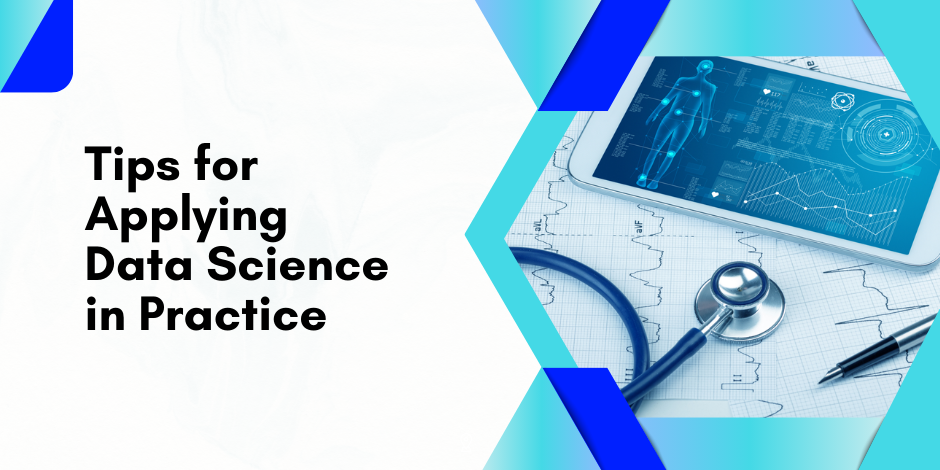Tips for Applying Data Science in Practice

Stay Informed With Our Weekly Newsletter
Receive crucial updates on the ever-evolving landscape of technology and innovation.
Data science is a rapidly growing field that has become indispensable in today’s digital age.
Around 328.77 million terabytes of data are generated every day, and further statistics suggest that roughly 90% of the world’s data has been produced in just the last two years.
Organisations have begun increasingly applying data science techniques to gain valuable insights and make data-driven decisions.
Whether you are new to data science or looking to enhance your existing knowledge, this article will provide essential tips for effectively applying data science in practice.
Understand the basics of data science

Applying data science is the process of extracting knowledge and insights from structured and unstructured data.
It involves analysing and interpreting data using various statistical methodologies, machine learning algorithms, and predictive modelling techniques.
In today’s world, applying data science is crucial in solving complex business challenges and driving innovation.
The importance of data science in today’s world
Applying data science can revolutionise industries by uncovering hidden patterns, trends, and correlations in large datasets.
With data increasing in volume and complexity, businesses need data scientists to help them make sense of it and make informed decisions.
Data science has become a game-changer from retail and healthcare to finance and marketing.
In addition to impacting businesses, data science plays a crucial role in shaping government policies and public services.
Policymakers can make evidence-based decisions that benefit society by analysing data related to demographics, public health, and social welfare.
Data-driven governance is becoming increasingly prevalent, leading to more efficient and transparent decision-making processes.
Key concepts and terminologies in data science
Before diving into the technical aspects of applying data science, it is essential to understand some key concepts and terminologies.
These include data preprocessing, feature engineering, supervised learning, unsupervised learning, and model evaluation metrics.
Familiarise yourself with these terms to navigate the data science landscape effectively.
Moreover, data science is a constantly evolving field, with new techniques and tools being developed regularly.
Staying updated with the latest trends and advancements in data science is crucial for professionals in the field to remain competitive and deliver impactful solutions.
Continuous learning and upskilling are essential to thrive in the dynamic landscape of data science.
Programs like the Institute of Data’s Data Science and AI program can help to keep your skills sharp.
Prepare for applying data science

Preparing for a data science application involves gathering and cleaning your data.
Clean and reliable data is crucial to achieving accurate and actionable results.
Perform data cleaning techniques such as removing duplicates and handling missing values.
Additionally, choosing the right data science tools are essential when applying data science. Explore popular tools like Python, R, and SQL to streamline your data science workflows.
Gather and clean your data
Gathering data involves identifying relevant data sources and collecting data from multiple platforms.
It may include scraping websites, accessing Application Programming Interfaces (API) data, or utilising internal databases.
Once the data is collected, perform data cleaning techniques to ensure data quality.
Data cleaning involves handling missing values, removing outliers, and transforming variables to make them suitable for analysis.
Choose the right data science tools
The choice of data science tools depends on the specific requirements of your project.
Python is a popular programming language for data science due to its rich libraries such as NumPy, Pandas, and Scikit-learn.
R, another widely used language, offers excellent statistical analysis capabilities. SQL is essential for working with relational databases.
Familiarise yourself with these tools to analyse and visualise your data effectively.
Practise practical data science techniques
Now that you have a solid foundation in data science, let’s explore some practical techniques you can use to derive insights from your data.
Machine learning and predictive modelling are powerful techniques that enable you to build models that can predict future outcomes based on historical data.
Data visualisation techniques, such as charts, graphs, and interactive dashboards, help you communicate your findings effectively.
Machine learning and predictive modelling
Machine learning algorithms allow computers to learn and make predictions without being explicitly programmed.
By training your model on historical data, you can make predictions on future data.
Popular machine learning algorithms include linear regression, decision trees, random forests, and neural networks.
Experiment with different algorithms to find the best fit for your data.
Data visualisation techniques
Data visualisation is an essential aspect of data science that helps you communicate your findings effectively.
Visualising data through charts, graphs, and interactive dashboards enables you to uncover patterns and trends that may not be apparent from raw data.
Tools like Tableau, Power BI, and Matplotlib can assist you in creating compelling visualisations.
Implement data science in your organisation

Implementing data science in your organisation can be a transformative process that drives informed decision-making and boosts productivity.
Building a data-driven culture involves fostering an environment where data is valued and utilised in decision-making processes.
Encourage your team to embrace data-driven decision-making and provide them with the necessary training and resources to enhance their data literacy skills.
You can unlock your organisation’s full potential by applying data science to the core of your organisation’s operations.
Conclusion
Applying data science in practice can be a rewarding and impactful endeavour.
By understanding the basics, you can harness the power of data to drive innovation and make informed decisions.
Remember to measure the impact of your data science initiatives and continually improve your skills to stay at the forefront of this ever-evolving field.
If you would like to get qualified in data science, you can download a copy of the Institute of Data’s Data Science & AI program outline for free to see what it entails.
Alternatively, we invite you to schedule a complimentary career consultation with a member of our team to discuss the program in more detail.




